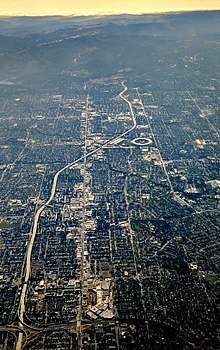Apple Park
| Apple Park | |
|---|---|
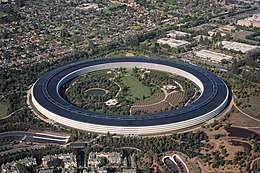 Apple Park aerial view in 2018. | |
 Location within California | |
| Alternative names |
Apple Campus 2 One Apple Park Way |
| General information | |
| Status | Complete |
| Architectural style | Neo-futurism |
| Location | Cupertino, California |
| Address | 1 Apple Park Way[1] |
| Country | United States |
| Coordinates | 37°20′5″N 122°0′32″W / 37.33472°N 122.00889°WCoordinates: 37°20′5″N 122°0′32″W / 37.33472°N 122.00889°W |
| Groundbreaking | November 2013 |
| Opening | April 2017[2] |
| Cost | $5 billion (the land cost was estimated at $160 million)[3] |
| Owner | Apple Inc. |
| Dimensions | |
| Circumference | 1 mile (1.6 km) |
| Other dimensions | Accommodating more than 12,000 staff[2] |
| Technical details | |
| Floor count | 4[4] |
| Floor area | 2,800,000 sq ft (260,000 m2)[4] |
| Grounds | 175 acres (71 hectares)[2] |
| Design and construction | |
| Architect | Norman Foster[5] |
| Architecture firm | Foster and Partners[4] |
| Structural engineer | Arup[6] |
| Services engineer | Arup[6] |
| Other information | |
| Parking | 14,200 |
Apple Park is the corporate headquarters of Apple Inc., located at 1 Apple Park Way in Cupertino, California, United States. It opened to employees in April 2017, while construction was still underway. Its research and development facilities are occupied with more than 2,000 people. It superseded the original headquarters at 1 Infinite Loop, which opened in 1993.[7]
Its circular design and extreme scale have earned a media nickname of "the spaceship".[8][9][10] Located on a suburban site totaling 175 acres (71 hectares), it houses more than 12,000 employees in one central four-storied circular building of approximately 2,800,000 square feet (260,000 square meters). Steve Jobs wanted the whole campus to look less like an office park and more like a nature refuge. Eighty percent of the site consists of green space planted with drought-resistant trees and plants indigenous to the Cupertino area, and the center courtyard of the main building features an artificial pond.[10]
History
In April 2006, Apple's former CEO Steve Jobs announced to the city council of Cupertino that Apple had acquired nine contiguous properties to build a second campus, the Apple Campus 2.[11] The idea for a new headquarters was conceived by Jobs and Apple's chief designer Jony Ive.[12] Ive was Apple's immediate choice to design the project, going on to work very closely together with Norman Foster across five years, designing every detail, from the glass panels to the elevator buttons.
Purchases of the needed properties were made through the company Hines Interests,[13][14] which in at least some cases did not disclose the fact that Apple was the ultimate buyer;[14] Philip Mahoney, a partner with a local commercial real estate brokerage, noted that this is common practice in attempts to arrange the purchase of contiguous land made up of multiple parcels with separate owners, in order to keep costs from skyrocketing and not reveal the company's plans to competitors.[14] Among the sellers of the properties were SummerHill Homes (a plot of 8 acres or 3.2 hectares) and Hewlett-Packard (three buildings of their campus in Cupertino), among others.[14]
Until April 2008, Apple had not sought the necessary permits to begin construction, so it was estimated that the project would not be ready in 2010 as originally proposed; however, the buildings on the site are held by Apple for its operations. In November 2010 the San Jose Mercury News revealed[15] that Apple had bought an additional 98 acres (40 ha) no longer used by HP Inc., just north across Pruneridge Ave. This space had been the HP campus in Cupertino before it was relocated to Palo Alto.
On June 7, 2011, Steve Jobs presented to Cupertino City Council details of the architectural design of the new buildings and their environs.
On October 15, 2013, Cupertino City Council unanimously approved Apple's plans for the new campus after a six-hour debate.[16] Shortly thereafter, demolition work began to prepare the site for construction.[17]
On February 22, 2017, Apple announced the official name of the campus to be "Apple Park", and the auditorium to be named "Steve Jobs Theater".[2]
Originally expected to break ground in 2013 and open in 2015, the project experienced delays and started in 2014.[18][19] The campus opened for workers in April 2017, despite continued construction work.[20] This was followed by the first event in the Steve Jobs Theater, which took place on September 12, 2017.[21] Apple Park Visitor Center opened on September 17, 2017.[22]
As a consequence of the presence of Apple Park in the area, surrounding streets have met with both increased tourism, along with rising real estate values of local housing, often drawing in Apple employees wanting to live near the workplace.[23][24]
Location
Apple Park is located one mile east of the original Apple Campus. Apple has had a presence in Cupertino since 1977, which is why the company decided to build in the area rather than move to a cheaper, distant location. The campus is also next to a contaminated site under Superfund legislation with a groundwater plume.[25]
Design
Steve Jobs, in his final public appearance before his death in October 2011:
It's got a gorgeous courtyard in the middle, and a lot more. It's a circle, so it's curved all the way round. This is not the cheapest way to build something. Every pane of glass in the main building will be curved. We have a shot, at building the best office building in the world. I really do think that architecture students will come here to see it.[26]
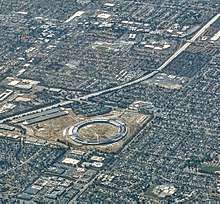
The ring-shaped building, advertised as "a perfect circle," was not originally planned as such. The inner rim and outer rim on each floor are left open as walkways. There are 8 buildings, separated by 9 mini-atria. The campus is one mile (1.6 km) in circumference, with a diameter of 1,512 feet (461 m). The one circular building houses most employees. It is four stories above the ground and three stories underground. Apple created life-size mock-ups of all parts of the building to analyze any design issues.
The design hides the roads and parking spaces underground. The campus uses only glass for its walls and views of the inner courtyard or to the landscape facing the exterior of the building. Around 83,000 square feet (7,700 m2) of space is for meetings and breakout spaces in the building. The inner part of the circular building contains a 30-acre (12 ha) park featuring a pond, with fruit trees and winding pathways inspired by fruit orchards of California.
Steve Jobs wanted no seam, gap, or paintbrush stroke visible for a clean fit and finish.
All interior wood used for furniture was harvested from a certain species of maple, with Apple working with construction companies from 19 countries for design and material supply.
A breathing, hollow concrete slab acts as the building's floors, ceilings, and HVAC system. A total of 4,300 such slabs have been used for building. Some of the slabs weigh 60,000 pounds (27 t).
During construction, the building core and shell were started by DPR/Skanska, but they were removed from the job for undisclosed reasons. Rudolph & Sletten and Holder Construction worked to complete core and shell along with the interior fit-out.
Costs
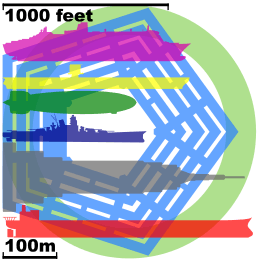
The land cost was estimated at $160 million. In 2011, the budget for Apple’s Campus 2 was less than $3 billion.[27] However, in 2013 the total cost was estimated to be closer to $5 billion.[27][28]
Energy supply
Apple states that the entire complex may eventually be powered entirely from renewable energy. The whole site is one of the most energy-efficient buildings in the world.[2] The solar panels installed on the roof of the campus can generate 17 megawatts of power, sufficient to power 75% during peak daytime,[29] and making it one of the biggest solar roofs of the world. The other 4 megawatts are generated onsite using Bloom Energy Server fuel cells, which are powered by biofuel or natural gas.[30] The air flows freely between the inside and outside of the building, providing natural ventilation and obviating the need for HVAC systems during nine months of the year.[2]
Facilities
Cafés
The campus has seven cafés, with the largest being a three-level café for 3,000 sitting people. It has light-colored stone lining and glass railing with no metal support, and is surrounded by extensive landscaping. The mezzanine space of 20,000 sq ft (1,900 m2) can accommodate 600 people and 1,750 seats on terraces outside, with a capacity to serve 15,000 lunches a day, housed by specially designed 500 tables made of solid spesshart white oak, measuring 18 ft (5.5 m) long and 4 ft (1.2 m) wide.
The sports tables and benches resemble those in Apple Stores. The large doors of the three-level restaurant are 92 ft (28 m) tall, the biggest in the world. The café extends to the grassy landscaped area well beyond the glass walls, and offers al fresco dining in an area Apple has called the glade.
Auditorium
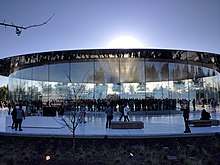
Officially known as the Steve Jobs Theater,[2] after the co-founder and former CEO of Apple, the facility is located atop a hill on the campus. It is an underground, 1,000-seat auditorium intended for Apple product launches and press meets. It has a large above-ground cylinder-shaped lobby with stairs down to the auditorium. The theater has 350 parking spaces on North Tantau and a pedestrian path leading to the main campus located northwest of the theater. This provides Apple with more control over product releases and unveilings.
The theater's lobby has cylindrical-shaped glass walls and no support columns, which give an unhindered 360-degree view of the surrounding campus. The 80-short-ton (73-metric-ton) carbon fiber roof, made of 44 identical panels, was supplied by the Dubai-based company, Premier Composite Technologies. Each panel is 70 ft (21 m) long and 11 ft (3.4 m) wide and locks in the middle with the other panels.[31] It is the largest carbon-fiber roof and the largest glass-supported structure in the world.[32]
The theater also includes a 42-foot (13 m) high glass elevator that rotates 171 degrees from the bottom to upper lobby level. The elevator is made from chemically-tempered glass, and is considered to be the tallest free-standing, glass elevator in the world.[32]
The theater's first press event was held on September 12, 2017 at 10:00 PDT, where the iPhone 8, iPhone 8 Plus, iPhone X, Apple Watch Series 3 and Apple TV 4K were announced.[33]
Wellness center
A 100,000-square-foot (9,300 m2) fitness center is located in the northwest of the campus. It can serve up to 20,000 employees from around the area. Apart from gym equipment, the fitness center features other amenities like changing rooms, showers, laundry services, and rooms for group sessions.
Research and development facility
The research and development facilities feature two large 300,000 square feet (28,000 m2) buildings on the southern edge of the campus. The top floor of each building houses the department comprising industrial design and human interface teams headed by design chief Jonathan Ive.
Transportation
Bus
Employees traveling by bus will board and depart from the subterranean bus station, which leads to the main campus via two white staircases. The area is also served by the Santa Clara Valley Transportation Authority, which runs local bus service from Cupertino to nearby cities.
Vehicles
Parking is located both underground and in two large parking structures accommodating approximately 14,200 employees.[34] Cupertino regulations required a minimum of 11,000 parking spaces,[35] 700 of which have electric vehicle charging stations.[36]
There are 2,000 parking spaces in the subterranean parking garage. The parking is managed by sensors and apps, which manage the traffic and parking spaces.[37]
Cycling
There are 1,000 bikes on the campus for employees to get around, with miles of cycling and jogging trails all over the 175-acre (71 ha) campus. There are an additional 2,000 bicycle parking spaces in the subterranean car parking garage.[37]
Apple Park Visitor Center
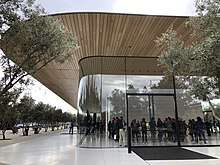
Apple Park Visitor Center is a two-story 20,135 sq ft (1,870.6 m2) structure with four main areas: an Apple Store[38] featuring Apple-branded merchandise (T-shirts, hats, tote bags, post cards) not sold at regular Apple stores[39], a 2,386 sq ft (221.7 m2) café, an exhibition space which currently showcases a 3D model of Apple Park with augmented reality, and a roof terrace overlooking the campus. It opened to the public on November 17, 2017.[40][41] The estimated cost of the center is $80M.[42] The property at 10600 N. Tantau (NE corner of Tantau and Pruneridge) is across the road from the campus proper and abuts a Santa Clara residential neighborhood.[43] The underground parking garage, with close to 700 spaces, has an estimated cost of $26 million.
Grounds
Landscaping
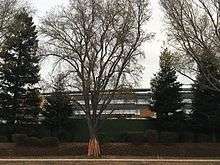
When construction is complete, 80% of the campus will consist of green space.[44] The big courtyard in the middle of the main building will be verdant with apricot, olive, and apple orchards, as well as a herb garden near the cafe. The plants selected for the campus landscape are drought tolerant. Recycled water is used to water the campus.
In 2011, Apple hired an arborist, Dave Muffly, to cultivate California's natural environment around Apple Park.[45] Apple's headhunters tracked down Muffly in 2010 after Jobs recognized the quality of the oak trees near the Stanford Dish and asked his people to find the arborist who was caring for them.[45]
There are 9,000 trees on the Apple Park campus, of 309 varieties of indigenous species.[2][10] The planted trees are Oak savanna, Oak wood, and fruit trees including apricot, apple, plum, cherry and persimmon. An additional 15 acres (6 ha) are used for a native California grassland.[46] Among the apple varieties represented are Golden Delicious, Granny Smith, Gravenstein, and Pink Lady, but the McIntosh is notably absent.[45]
After he began work in earnest, Muffly realized that less than a hundred of the 4,000 existing trees were actually usable.[45] This meant he had to procure from scratch almost all of the 9,000 planned trees.[45] His team went so far as to search abandoned Christmas tree farms, and Apple actually bought one at Yermo in the Mojave Desert.[45]
Historic barn
The land that Apple purchased for the campus came with an old barn that was built in 1916 by John Leonard using redwood planks. Leonard married into the Glendenning Family, who immigrated to the United States from Scotland and settled in the area in the 1850s. After Apple purchased the property, there were discussions between Apple, the City of Cupertino, and the Cupertino Historical Society as to the fate of the barn. The city had an interest in the fate of the barn, because the city declared the barn in 2004 as a historical site.[47]
Eventually Apple agreed to keep the barn on the property, and is using it to "store maintenance tools and other landscaping materials". The barn was disassembled during the campus construction and then reassembled in a different location from where it was originally located.[48][49]
Inner courtyard
The inner courtyard is 30 acres (12 ha), and covered in fruit trees with a pond.
Criticism
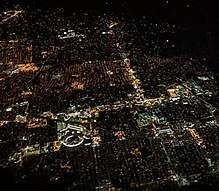
The design of the Apple Park campus has been called the "ultimate example" of suburban office parks, which have been in decline as companies seek to relocate to urban areas with better transit, bicycle, and pedestrian access.[50] Kaid Benfield of the Natural Resources Defense Council, a non-profit environmental advocacy group, criticized the proposed campus for contributing to existing suburban sprawl, with car-dependent features and waste of expensive real estate that could have been used for affordable housing.[51]
The headquarters also gained unfavorable attention when it emerged in 2018 that two workers had been injured and required hospital treatment after walking into the building's clear glass walls and doors.[52]
Apple has seen some criticism for the perceived extravagance of its new headquarters, as well as its perfectionist approach to its design and construction. The use of special wood as a construction material was reported to be the subject of a 30-page guideline.[53] The design of door handles was reported to be the subject of a one and a half year debate, involving several revisions before the Apple management gave its approval.[54] Apple's desire for custom signage put the company at odds with the Santa Clara County Fire Department, requiring several rounds of negotiations due to fears it could compromise safety in case of emergency.[55]
References
- ↑ "Trademark/Service Mark Application, Principal Register". USPTO.
- 1 2 3 4 5 6 7 8 "Apple Park opens to employees in April". Apple Newsroom. Apple Inc. Retrieved February 22, 2017.
- ↑ Apple Campus 2 cost 5 billion Projects: Foster and Partners
- 1 2 3 "Apple Campus 2: Project Description" (pdf). City of Cupertino. Cupertino, CA: Apple Inc. Sep 2013. Retrieved June 17, 2014.
- ↑ Wainwright, Oliver (November 15, 2013). "All hail the mothership: Norman Foster's $5bn Apple HQ revealed" – via The Guardian.
- 1 2 "Request for Proposal: Professional Construction Inspection and Public Works Inspection Services for the City of Cupertino for the Apple Campus 2 Project". City of Cupertino. Cupertino, CA: City of Cupertino – Inspection Services. November 12, 2013. Archived from the original (pdf) on November 6, 2014. Retrieved June 17, 2014.
- ↑ Reisinger, Don (May 31, 2016). "Apple Campus 2 Looking Good in New Drone Flyover". Fortune.
- ↑ Moore, Amy. "Complete guide to Apple Park, Apple's new 'spaceship' campus". Macworld UK. Retrieved May 7, 2017.
- ↑ VanHemert, Kyle. "Look Inside Apple's Spaceship Headquarters With 24 All-New Renderings". WIRED. Retrieved May 7, 2017.
- 1 2 3 O'Brien, Chris (June 4, 2016). "A look at Apple's insanely ambitious tree-planting plans for its new spaceship campus". VentureBeat.
- ↑ "Cupertino : News : Apple Campus 2 Project Update". 2013-07-09. Retrieved 2018-09-15.
- ↑ Tetzeli, Rick (December 2017). "Why Jony Ive Is Apple's Design Genius". Smithsonian. Retrieved May 16, 2018.
- ↑ Sharon Simonson (April 21, 2006). "Apple teams with Texas firm on new Cupertino campus". San Jose Business Journal. Retrieved May 10, 2010.
- 1 2 3 4 Chandler, Michele (Apr 28, 2006). "How Apple found 50 acres in Cupertino and why they paid big bucks for it". San Jose Mercury-News. Archived from the original on June 28, 2006. Retrieved September 27, 2014.
- ↑ Bailey, Brandon (August 13, 2016). "Apple makes big land purchase in Cupertino". The San Jose Mercury News.
- ↑ May, Patrick (October 15, 2013). "Cupertino council clears huge Apple 'spaceship' campus for liftoff". San Jose Mercury News. Retrieved October 16, 2013.
- ↑ Clover, Juli (December 5, 2013). "Demolition at New Apple Campus 2 Well Underway". MacRumors.
- ↑ Fry, Stephen (May 26, 2015). "When Stephen Fry met Jony Ive the self-confessed tech geek talks to Apple's newly promoted chief design officer". telegraph.co.uk. The Telegraph. Archived from the original on May 31, 2015. Retrieved May 31, 2015.
- ↑ Peter Burrows (November 21, 2012). "Jobs's Spaceship-Like Apple Offices Completion Meets Delays". Bloomberg.com. Bloomberg. Retrieved February 27, 2013.
- ↑ "Apple's spaceship campus, Apple Park, opens in April". The Verge. Retrieved June 26, 2018.
- ↑ "Apple's iPhone 8 event is happening on September 12th". The Verge. Retrieved June 26, 2018.
- ↑ "You too can now visit the new Apple Park campus". CNET. November 17, 2017. Retrieved June 26, 2018.
- ↑ Leong, Kathy Chin (July 4, 2017). "Apple Disrupts Silicon Valley With Another Eye-Catcher: Its New Home". The New York Times. Retrieved July 18, 2017.
- ↑ Broussard, Mitchel (July 5, 2017). "Houses Near Apple Park Met With Increased Tourism and Rising Real Estate Values". MacRumors. Retrieved July 18, 2017.
- ↑ Hugh Biggar (June 7, 2006). The Cupertino Courier.
- ↑ Lashinsky, Adam (February 23, 2017). "Steve Jobs' Legacy Lives On in Apple's New Campus". Fortune.
- 1 2 Burrows, Peter. "Inside Apple's Plans for Its Futuristic, $5 Billion Headquarters". Businessweek. Retrieved May 28, 2013.
- ↑ "Apple Campus 2 nearly $2 billion over budget and behind schedule, says Bloomberg". The Verge. Retrieved April 4, 2016.
- ↑ "Cupertino : City News : Steve Jobs Presents to Cupertino City Council". Cupertino City Council.
- ↑ "Apple's Campus 2 to use updated Bloom Energy fuel cells first deployed at NC data center". Apple Insider.
- ↑ Murphy, Mike. "What is Apple actually doing besides building that ridiculously expensive new headquarters?".
- 1 2 www.fosterandpartners.com, Foster + Partners /. "The Steve Jobs Theater at Apple Park – Foster + Partners". www.fosterandpartners.com. Retrieved November 1, 2017.
- ↑ "Apple's iPhone 8 event is happening on September 12th". The Verge. Retrieved September 11, 2017.
- ↑ Moore, Amy. "Apple sends out photos of near-complete Campus 2 HQ ahead of 2017 launch". Macworld.
- ↑ Leswing, Kif (April 9, 2017). "Apple's new $5 billion campus has more space for parking than offices". BusinessInsider.
- ↑ "Environmental Responsibility Report" (PDF). Apple Inc. 2017.
- 1 2 Myllenbeck, Kristi (February 24, 2017). "Apple Park: Cupertino shares insights into traffic, sheer size of project". The Mercury News.
- ↑ "Here are all the details on Apple Park, the company's massive new spaceship campus". Fast Company. February 22, 2017. Retrieved May 16, 2017.
- ↑ "Apple Park Visitor Center Set to Open by Year's End (Byways Magazine)". Byways. Retrieved October 30, 2017.
- ↑ Hein, Buster (November 17, 2017). "Apple Park visitor center opens doors to the public | Cult of Mac". Cult of Mac. Retrieved November 17, 2017.
- ↑ Wuerthele, Mike. "Apple Park visitors center complete, slated to open before end of 2017". AppleInsider. Retrieved October 30, 2017.
- ↑ Campbell, Mikey (January 18, 2016). "Apple to spend $80M on Campus 2 visitor center". AppleInsider.
- ↑ Elmer-DeWitt, Philip (July 30, 2015). "Apple visitor's center will offer views of Steve Jobs' Spaceship". Fortune.
- ↑ "Steve Jobs TV Appearance at the Cupertino City Council (6/7/11)". YouTube. July 6, 2011. Retrieved May 16, 2017.
- 1 2 3 4 5 6 Levy, Steven (June 1, 2017). "Apple Park's Tree Whisperer". Wired. San Francisco: Condé Nast. Retrieved March 19, 2018.
- ↑ "California Native Grasslands Association – Grass Facts".
- ↑ "Barn at Apple Park represents 'hard work' of generations of 'visionaries'". San Jose Mercury News. July 14, 2017.
- ↑ Rossignol, Joe (July 13, 2017). "Apple Has Finished Moving and Precisely Reassembling a Historic Barn At Its New Headquarters".
- ↑ Myllenbeck, Kristi (July 14, 2017). "Barn at Apple Park represents 'hard work' of generations of 'visionaries'". San Jose Mercury News.
- ↑ Goodyear, Sarah (June 14, 2011). "As suburban office parks lose steam, Apple unveils the ultimate example". Grist. Retrieved December 4, 2017.
- ↑ Benfield, Kaid (March 13, 2012). "If you care about cities, return that new iPad". Natural Resources Defense Council. Archived from the original on May 4, 2012. Retrieved December 4, 2017.
- ↑ https://www.marketwatch.com/story/people-are-walking-into-glass-at-the-new-apple-headquarters-2018-02-15
- ↑ Love, Julia. "Channeling Steve Jobs, Apple seeks design perfection at new..." U.S. Retrieved May 28, 2018.
- ↑ Loterina, Chris (February 8, 2017). "Apple Repeated Delays To Perfect Spaceship Campus Reveal Why It Is Extravagantly Anti-People". Tech Times. Retrieved May 28, 2018.
- ↑ "Apple's 'spaceship' campus: more than a year to approve a door handle, and toilets like iPhones, report says". SiliconBeat. February 7, 2017. Retrieved May 28, 2018.
External links
| Wikimedia Commons has media related to Apple Park. |
- Apple Park – One More Thing: Inside Apple’s Insanely Great (Or Just Insane) New Mothership article, Wired.com
- Apple Park – cycling the Infinite Loop with interactive map, Kinomap
- Steve Jobs Presents to the Cupertino City Council (6/7/11) – Steve Jobs presenting his plans for the Apple Park at the Cupertino Community Hall, YouTube
